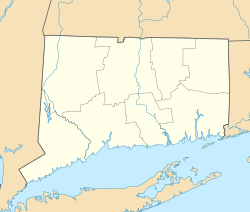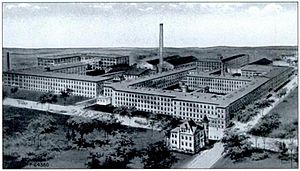Seaside Institute facts for kids
Quick facts for kids |
|
|
Seaside Institute
|
|
 |
|
| Location | 285 Lafayette Avenue, Bridgeport, Connecticut |
|---|---|
| Built | 1887 |
| Architect | Warren R. Briggs |
| Architectural style | Richardsonian Romanesque |
| NRHP reference No. | 82004374 |
| Added to NRHP | June 14, 1982 |
The Seaside Institute is a historic building in Bridgeport, Connecticut. It was built in 1887 and designed by Warren R. Briggs. The building has a special style called Richardsonian Romanesque. It uses materials like granite, brick, and brownstone.
The Institute was first built for the women who worked at the Warner Brothers Corset Company. It gave them a place to eat, learn, and relax. Today, the building is used by the Bridgeport International Academy. It was added to the National Register of Historic Places in 1982.
Contents
Building History
In 1886, the Warner Brothers Corset Company was a big employer in Bridgeport. About 1,200 people worked there, and most of them were women. The company's founders, Drs. I. D. and Lucien C. Warner, wanted to help their female employees.
They built the Seaside Institute as a special place for these women. It had a dining hall, rooms for lectures, a library, and places for music and reading. This was an example of 19th-century philanthropy. This means wealthy people or companies gave money to help others. It was also a type of industrial paternalism. This is when employers provide benefits to their workers to improve their lives.
Why the Institute Was Built
The Warners believed in treating their workers well. They wanted to offer a safe and helpful environment. An article from 1887 in The Century talked about their kindness. It said that employers like the Warners were important. They helped working women who often faced tough conditions. The Institute aimed to give these women a better place to spend their time.
The Seaside Institute opened in 1887. The wife of the President, Frances Folsom Cleveland, even attended the opening ceremony. For many years, the Institute served its purpose. By 1917, the Warner company had about 2,200 women employees. The Institute offered meals, a library, and classes. Organizations like the Young Women's Christian Association taught some of these classes.
Impact and Changes Over Time
Many people saw the Institute as a good example of how to solve problems of the time. It was thought to help with worker happiness by paying fairly. It also offered a positive place for women who worked outside the home. The Institute even tried to offer an alternative to places like saloons for workers.
During World War I, there was a shortage of workers. Warner Brothers used the Institute's features to attract more women. They described "club rooms" where employees could take classes. These included gymnastics, embroidery, and English. However, even with these benefits, women workers still wanted better pay and working conditions. For example, in 1915, some workers went on strike. They wanted an eight-hour day.
Bridgeport International Academy
In 1994, a company called UBA Inc. bought the Seaside Institute building. Later, it became the home of the Bridgeport International Academy. Today, the building houses both the Academy and the Bridgeport Hope School. The Bridgeport Hope School is a private elementary school for grades K-8.





